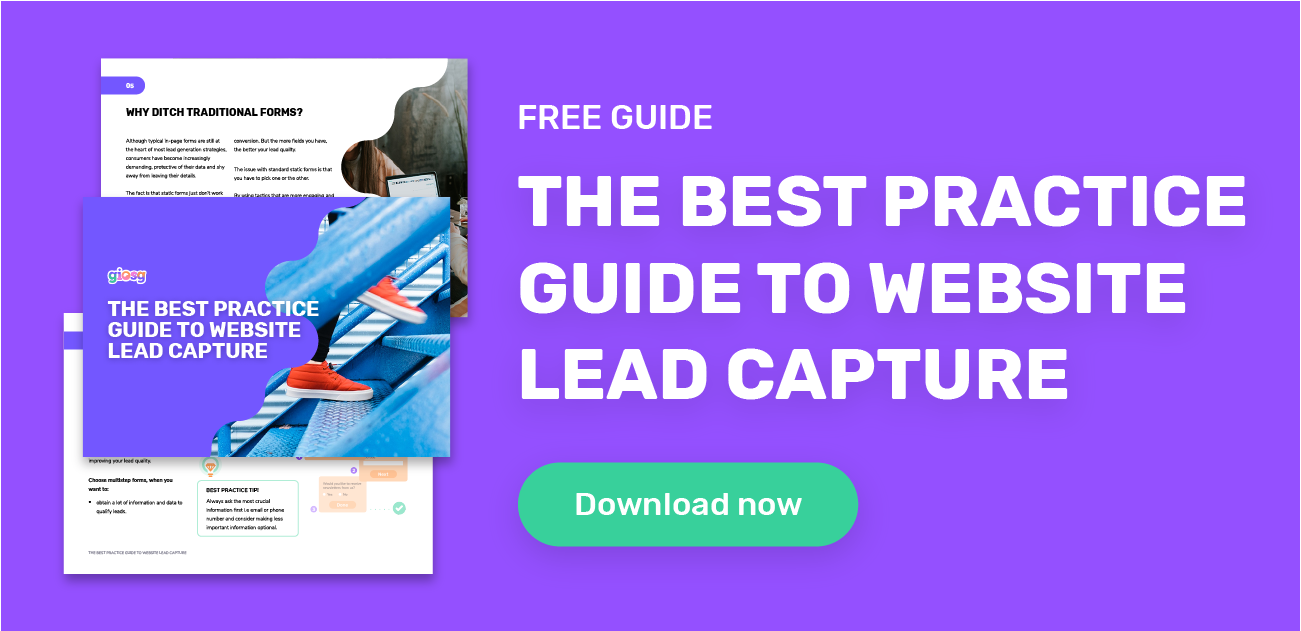Improving lead generation will help your sales build their pipeline and ultimately close more sales. This is a no brainer, right?
But 63% of marketers say that lead generation is their biggest challenge. And when it comes to the B2B space, things tend to get a little trickier as there are often multiple stakeholders involved in the purchasing process.
Your website plays a significant role in the often rather complex sales process, especially in lead capture. That’s why we’ve gathered a few tips for improved B2B lead generation on your website:

1. Minimise the use of static lead capture forms
Old static forms hidden on specific pages no longer do the trick. Your potential leads don't have the time nor the patience to go searching for information or your contact pages. Replacing static forms with interactive elements on your website can help you cut through the noise and stand out from competitors.
In fact, B2B customers today often expect the same personalised and engaging interactions they experience in consumer markets. Elements to consider for better converting in B2B are button-based bots and personalised pop-ups, to name a few.
Interactive pop-ups can be especially engaging and as a general rule of thumb from our experience can generate at least 3X more leads than static forms.
By implementing a targeted newsletter subscription pop-up onto their eCommerce site our customer, a Nordic cleaning brand was able to increase the number of subscriptions per week by 4X. On the other hand, Button-based bots can help automate your lead generation, website navigation and collect further valuable insights about online visitors.
2. Implement live chat
Live chat is not merely a B2C conversion tactic and is equally as effective for B2B lead generation.
In fact, implementing live chat can increase the total number of leads collected by 30%. B2B companies like Delete, our customer, have been able to source 25% of their proposal requests through live chat.
As with interactive content, live chat is there to provide a fast efficient service online giving your visitor the possibility to engage directly with your business. It also gives your sales representatives the opportunity to converse with potential prospects - helping them turn visitors into leads.
So, live chat is not only great for building engagement and helping your customers but crucial for generating sales-ready leads.
Our customer, Fonecta who both use and provide live chat to their customers have helped turn 50% of live chat conversations into sales leads across their entire customer base. Now that’s impressive!
3. Provide clear CTAs
Whatever type of lead generation elements you decide to place on your website, the call to action should be clear, compelling and straight forward. You need to tell your website visitors what exactly it is that you want them to do, otherwise you run the risk of them not taking the actions you intended. Your CTA should be engaging and provide visitors with something that is valuable to them so that the incentive for giving their contact information is there.
The bottom line: Whatever your offer is, be clear about it and make sure your copy reflects that. Keep in mind that the colour, size, copy, and placement of your CTA can all affect conversion - that's why it’s a great element to A/B test to optimise results.
4. Keep your lead gen forms short
No one wants to fill out a form with ten different fields, whether static or interactive. The less information the visitor needs to give, the more likely it is that they fill it. A newsletter subscription shouldn't really require more than an email address.
However, in some cases, the value provided is higher i.e. an event or webinar sign-up at which point asking for more information from the visitor might be justified.
In general, email is probably the most important piece of information you will ask for. A simple trick is to specify that the visitor fills out their work email address, instead of just a generic email address.
This way when nurturing that lead, emails will go to the correct address and content will be read in the relevant medium.
5. Target your lead-generating content
Today, there are numerous Artificial Intelligence and machine learning tools that can increase efficiency and that already play an important role in generating more B2B leads. It was predicted, 30% per cent of companies will be using AI by the end of this year in at least one of their sales processes.
However, we really wouldn't be surprised if this number was a lot higher!
Using AI-powered tools allow you to adapt your lead-generating content to correspond with the situational needs of a particular website visitor in real-time. In essence, it’s all about personalisation!
Even without the element of AI, by analysing website visitor data and understanding your online visitor behaviour, you can provide the right content, at the right time.
Knowing what pages are most visited, what your visitors do on those pages, what actions they take etc. helps you create and target content that is relevant to the visitor helping you increase conversions, from online visitor to lead.
It’s also useful to know the average website conversion rate by industry. That way you can not only compare your site’s performance against your past efforts and the competition, but also the wider market. This makes it easier to see whether you’re moving in the right direction with your content.
Want to learn more about optimising your lead capture strategy? Read our lead capture guide to increase your website conversions 😊👇
Editor's note: This blog was originally posted in 2019 but has been revamped and updated for accuracy.
